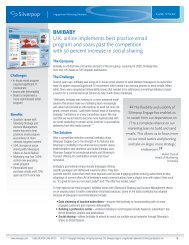eBook - Silverpop
eBook - Silverpop
eBook - Silverpop
Create successful ePaper yourself
Turn your PDF publications into a flip-book with our unique Google optimized e-Paper software.
4. Cross Promotion:<br />
Multi-channel marketing has been around<br />
for hundreds of years, but the digital world is<br />
making it even easier.<br />
Consider this example: Brand X promotes a “buy<br />
one get one free” offer via on its Facebook Page<br />
to its 250,000 followers.<br />
Emails promoting the deal go out on Tuesday,<br />
Thursday and Sunday to its 2 million subscribers,<br />
driving traffic to the Facebook Page. As a<br />
result, Brand X gets many times the coupon redemptions<br />
a social-only approach would deliver.<br />
5. Reach:<br />
While some brands have more than a million<br />
“Likes” (formerly known as Fans) on Facebook<br />
and hundreds of thousands of Twitter followers,<br />
many are still in the tens of thousands in these<br />
two kings of the social world.<br />
These same brands might have 10 to 100 times<br />
these numbers in their email databases. Although<br />
social networks are growing as marketing<br />
channels, your brand might never reach the<br />
same number of customers and prospects that<br />
you can contact directly via email.<br />
6. Conversion/Nurturing:<br />
By its very nature, social communication has a<br />
greater personality, human and conversational<br />
element. While better email programs mirror<br />
social messaging in these areas, email continues<br />
to be the channel consumers prefer for promotional<br />
messaging.<br />
Because of the ability to target, use dynamic<br />
content and put consumers into nurturing<br />
programs or tracks, email will continue to be the<br />
more successful channel at producing profitable<br />
conversions.<br />
7. Share of wallet:<br />
Increasing lifetime customer value is a primary<br />
marketing goal for most companies. The keys<br />
are increasing loyalty – share of wallet and repeat<br />
purchases – at higher margins than less loyal<br />
customers.<br />
Email is the only marketing channel that can leverage<br />
customer data and targeting technologies to<br />
drive these activities and build higher LCV.<br />
8. Channel Preferences:<br />
I’ve become a Facebook fan of Chipotle. I use its<br />
iPhone ordering app, and I’m becoming a frequent<br />
customer.<br />
Naturally, I signed up for Chipotle’s emails, once I<br />
tracked down the opt-in page. I’m still waiting for<br />
those.<br />
Because I’m in an older demographic, I check my<br />
email more frequently than my Facebook feed.<br />
Others like me, equally avid users of social media,<br />
also will prefer to receive certain types of communications<br />
from specific brands in email.<br />
Those message types might vary dramatically. But<br />
brands that don’t offer the choice via preference<br />
centers will miss opportunities to touch customers<br />
and prospects, consequently leaving money on the<br />
table.<br />
9. Dual purpose:<br />
Email and social work together to grow engagement<br />
in each channel. Email messages themselves<br />
can be designed to encourage social sharing and<br />
to build the company’s social following. At the<br />
same time, the social channel encourages opting<br />
in to the email program and amplifies email<br />
content.<br />
Marketers who can upgrade their email programs<br />
will find “mocial” won’t kill email. Instead, it can<br />
shift broadcast-type messages to social channels<br />
and clear the way for email to live up to its promise<br />
as a highly targeted and one-to-one messaging<br />
channel.<br />
SILVERPOP.COM | PAGE 88







